
Harbourfront is a neighbourhood on the northern shore of Lake Ontario within the downtown core of the city of Toronto, Ontario, Canada. Part of the Toronto waterfront, Harbourfront extends from Bathurst Street in the west, along Queens Quay, with its ill-defined eastern boundary being either Yonge Street or York Street. Its northern boundary is the Gardiner Expressway. Much of the district was former water lots filled in during the early 1900s to create a larger harbour district. After shipping patterns changed and the use of the Toronto harbour declined, the area was converted from industrial uses to a mixed-use district that is mostly residential and leisure.

The Toronto waterfront is the lakeshore of Lake Ontario in the city of Toronto, Ontario, Canada. It spans 46 kilometres between the mouth of Etobicoke Creek in the west and the Rouge River in the east.

Maple Leaf Stadium was a jewel box-style baseball stadium in Toronto, Ontario, Canada, located at the foot of Bathurst Street on the south side of Lake Shore Boulevard. It was built in 1926 by Lol Solman for his Toronto Maple Leafs baseball team of the International League. Previously, the Maple Leafs had played at Hanlan's Point Stadium. It continued to be the home of the Leafs for 42 seasons, until the team left town following the 1967 season. The stadium was demolished in 1968. Fans often referred to the stadium as the "Fleet Street Flats".

Bathurst Street is a main north–south arterial road in Toronto, Ontario, Canada. It begins at an intersection of the Queens Quay roadway, just north of the Lake Ontario shoreline. It continues north through Toronto to the Toronto boundary at Steeles Avenue. It is a four-lane thoroughfare throughout Toronto. The roadway continues north into York Region where it is known as York Regional Road 38.

The Randolph Theatre is a 518 seat theatre in Toronto, Ontario, that is housed in a former church. The Gothic revival building is located at 736 Bathurst Street at the intersection with Lennox Street. The theatre is in the former church sanctuary, while the 100-seat Annex Theatre is in an adjoining building at 730 Bathurst Street.
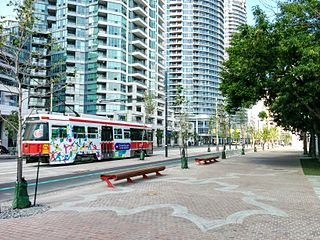
Queens Quay is a prominent street in the Harbourfront neighbourhood of Toronto, Ontario, Canada. The street was originally commercial in nature due to the many working piers along the waterfront; parts of it have been extensively rebuilt in since the 1970s with parks, condominiums, retail, as well as institutional and cultural development.
Dalhousie is a community in Heron Bay in Restigouche County, New Brunswick. It was a town from 1905 to 2023, when it was amalgamated with Charlo to form the town of Heron Bay. Heron Bay is the northernmost municipality in New Brunswick.

The Royal Bank Building refers to two office buildings constructed for the Royal Bank of Canada in Toronto financial district in Ontario, Canada:
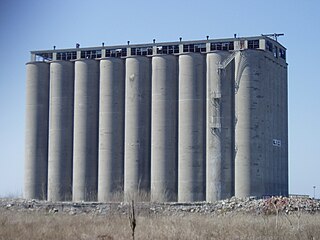
Victory Soya Mills Silos are abandoned soybean storage silos in Toronto, Ontario, Canada. The silos are located at the east end of Toronto Harbour, part of a soybean processing facility that operated from 1944 until 1991. The silos are of two remaining silos from Toronto's industrial port era.

Queen's Quay Terminal is a condominium apartment, office and retail complex in the Harbourfront neighbourhood in Toronto, Ontario, Canada. It was originally built in 1927 as a marine terminal with office, warehouse and cold-storage facilities. When shipping to Toronto declined in the 1960s and 1970s, the building was bought by the Government of Canada to be repurposed along with a section of the industrial waterfront. The Terminal Building itself was rebuilt in the 1980s with the addition of four floors of residential above the original facility, which was converted into retail and office uses. The cold storage wing was demolished and its plant building became The Power Plant gallery and Harbourfront Centre Theatre.
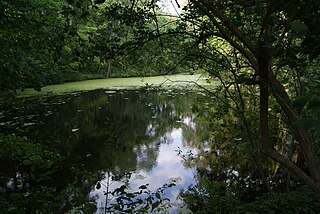
Wychwood Park is a neighbourhood enclave and private community in Toronto, Ontario, Canada. It is located west of Bathurst Street on the north side of Davenport Road, within the larger area of Bracondale Hill. It is considered part of the overall Wychwood official neighbourhood as designated by the City of Toronto.
Maple Leaf Mills Silos was one of two silo or grain elevator complexes that were built in the area between Spadina Quay and Maple Leaf Quay, on Toronto Harbour, in Toronto, Ontario, Canada. It was one of three "monumental" silo complexes that dominated the city's waterfront.
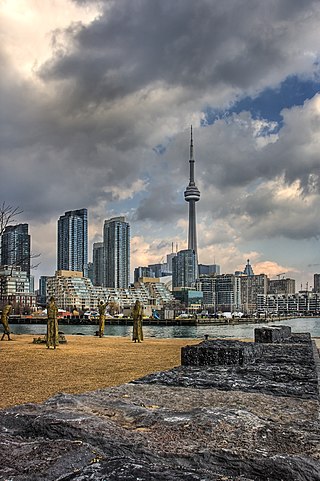
Ireland Park is located on the shores of Lake Ontario on Éireann Quay, adjoining the Canada Malting Silos, at the foot of Bathurst Street in Toronto, Ontario, Canada. Officially opened in the summer of 2007, Ireland Park commemorates the tens of thousands who fled Ireland during the Great Famine. In 1847, over 38,000 Irish men, women and children landed at Rees's Wharf on the shores of Toronto, fleeing famine and eager to start a new life. Although Toronto only had approximately 20,000 residents at the time, the city welcomed the newcomers with open arms. Over 1,100 new immigrants did not survive to make Canada their new home, with many perishing in fever sheds during the Typhus epidemic of 1847. Ireland Park is a tribute to all the Irish ancestors who came with only hope, for a new life in a promising country.
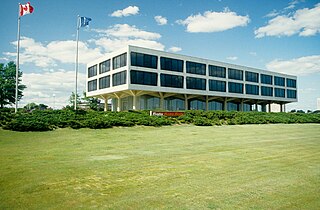
The Bata Shoes Head Office in Toronto, Ontario, Canada, was Bata Shoes' former headquarters. The white, pavilion-like building, designed by architect John B. Parkin and completed in 1965 was considered by many as an example of the Modern Movement in architecture. Located atop a hill on Wynford Drive, by the major intersection of Eglinton Avenue and the Don Mills Road in the district of North York, its architecture and location made it a well-known landmark in the city. It was identified by the Toronto Society of Architects as one of 96 significant buildings and public spaces in Toronto built between 1953 and 2003.

Railway Lands is an area in Downtown Toronto, Ontario, Canada. Originally a large railway switching yard near the Toronto waterfront, including the CNR Spadina Roundhouse and the CPR John Roundhouse, it has since been redeveloped and today is home to mostly mixed-used development, including the CN Tower and the Rogers Centre. The lands were owned and maintained by the Canadian National Railway and later transferred to the federal crown corporation Canada Lands Company. The area is bounded by Front Street, Yonge Street, Gardiner Expressway and Bathurst Street. The western portion of the Railway Lands is now part of the CityPlace neighbourhood and the eastern portion is now called South Core.
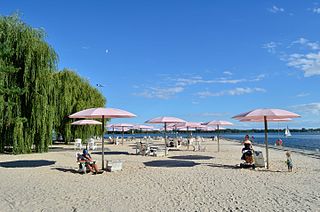
Sugar Beach is an urban beach park in Toronto, Ontario, Canada, that opened in 2010. It is located across from Redpath Sugar Refinery in Toronto's eastern East Bayfront. Like HTO Park to the west, the beach is not meant to allow wading or swimming in Lake Ontario, but rather functions as a waterfront public space for relaxation, leisure, and social activities. It cost $14 million.

Guild Park and Gardens is a public park in the Scarborough district of Toronto, Ontario, Canada. The park was formerly the site of an artist colony and is notable for its collection of relics saved from the demolition of buildings primarily in downtown Toronto arranged akin to ancient ruins. Located on the Scarborough Bluffs, Guild Park and Gardens has an outdoor Greek stage and a 19th-century log cabin among the oldest in Toronto. The principal building in the park is the Guild Inn, a former inn and estate mansion.
City School is an alternative high school in Toronto, Ontario, Canada. It is located in downtown Toronto at the Waterfront Neighbourhood Community Centre at Bathurst Street and Queens Quay West.

Quayside is a waterfront district Toronto, Ontario, Canada, located between Queens Quay East and Parliament Street. The 4.9 hectares site is owned by Waterfront Toronto, the City of Toronto and CreateTO and private landowners. In June 2023, Waterfront Toronto proposed a new master-planned mixed-use development of the former dockland and industrial site to succeed Sidewalk Toronto, an unrealised smart city proposed by Alphabet Inc. subsidiary Sidewalk Labs.
















